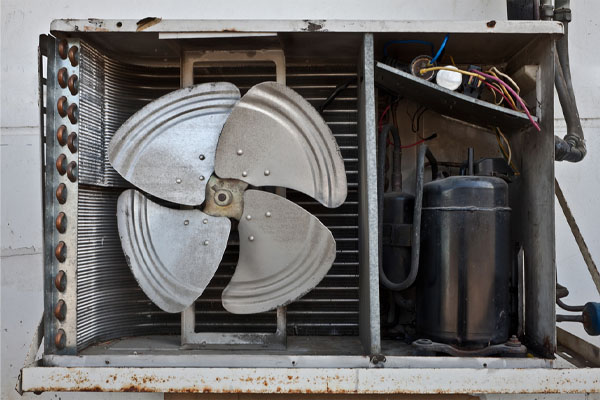Should You Replace Just The Outdoor AC Unit?

According to the US Department of Energy, the typical lifespan of an HVAC system ranges from 10 to 15 years. Yet, your system could surpass this expectancy with high-quality equipment and a robust maintenance routine.
To maximize the efficiency and longevity of your heating and cooling units, it is recommended to have your system professionally maintained twice a year, ideally before the peak of winter and summer. This proactive approach ensures optimal performance and extends your system’s operational life.
There comes a time when a full HVAC system replacement becomes inevitable. A frequent question posed by homeowners is, “Can you replace just the outside AC unit?” In this article, McAllister Energy, your trusted local HVAC expert, will address this inquiry comprehensively.
Is Replacing Only the Outdoor Air Conditioning Unit Feasible?
Contents
- 1 Is Replacing Only the Outdoor Air Conditioning Unit Feasible?
- 1.1 Matching Indoor and Outdoor Air Conditioner Components
- 1.2 Understanding SEER Ratings for AC Units
- 1.3 The Shift Away from R-22 Refrigerant
- 1.4 Understanding Manufacturer Warranties on Air Conditioners
- 1.5 Lifespan and Maintenance of Cooling Systems
- 1.6 Financial Impact of Partial AC Unit Replacement
- 2 Advantages of Replacing Both Indoor and Outdoor AC Units
- 3 Essential Tips for Maintaining Your Air Conditioner
- 4 FAQs About Replacing Air Conditioning Units
- 5 Conclusion
- 6 Call McAllister Energy for All Your HVAC Needs

The simple answer is no. HVAC experts highly recommend replacing both the outdoor and indoor units together when upgrading your home’s air conditioning system. While the decision ultimately lies with the homeowner, replacing only one component may result in reduced efficiency, increased likelihood of malfunctions, and elevated cooling costs.
Here are further insights into why pairing both units during replacement is crucial for maintaining peak performance.
Considering an HVAC Upgrade? Ensure optimal efficiency by pairing a matched indoor and outdoor unit. Contact McAllister Energy today to secure a system that performs at its best!
Matching Indoor and Outdoor Air Conditioner Components
The Air-Conditioning, Heating, and Refrigeration Institute (AHRI) underscores the necessity of ensuring compatibility between the outdoor AC unit and the corresponding indoor unit, or air handlers, to achieve maximum efficiency. These components must be specifically designed to function together seamlessly for optimal performance.
Replacing only the outdoor AC unit can create a mismatched system that might not effectively effectively meet your heating and cooling needs. Operating such a system can lead to several problems, such as reduced indoor comfort, the likelihood of premature system failure, and higher operating costs due to inefficiency.
Understanding SEER Ratings for AC Units
SEER, or Seasonal Energy Efficiency Ratio, is a measure used to gauge an air conditioner’s cooling efficiency. It compares the unit’s cooling output over a typical season against its annual energy consumption. This rating acts as a standard for assessing HVAC system efficiency, with the US Energy Information Administration (EIA) mandating a minimum SEER rating of 13 for systems operating in the United States.
A higher SEER rating indicates greater efficiency in an air conditioning system, which leads to lower operational costs and a smaller environmental footprint over its lifetime.
For optimal efficiency, it is essential that both the outdoor and indoor units of an AC system have matching SEER ratings. Replacing only the outdoor unit without matching the SEER rating of the indoor unit can create a discrepancy, resulting in inefficiency and various related problems.
A mismatched system with differing SEER ratings can lead to decreased cooling performance, higher energy usage, and an increased risk of mechanical failures. This highlights the critical importance of considering SEER ratings when upgrading any part of your HVAC system to ensure reliability and efficiency.
Fed Up with Inefficient Cooling and Rising Bills? Upgrade to a modern, energy-efficient AC system with McAllister Energy and start enjoying significant savings today. Call us now!
The Shift Away from R-22 Refrigerant
In response to global sustainability efforts, HVAC manufacturers are innovating with environmentally friendly designs and materials to minimize ecological impacts. Notably, older HVAC models often used R-22 refrigerant, which the U.S. Environmental Protection Agency (EPA) has identified as harmful to the ozone layer. This realization has driven a pivotal shift in industry standards and practices, steering towards more eco-conscious solutions.
In light of environmental concerns, federal regulations have been updated to mandate the use of other environmentally friendly refrigerants in all new HVAC units. These refrigerants are recognized for their minimal environmental impact and enhanced safety features.
For homeowners with systems still using R-22, upgrading to models that use eco-friendly refrigerants represents an efficiency improvement and a commitment to environmental protection. Such upgrades ensure compatibility between indoor and outdoor units, avoiding the inefficiencies and issues associated with mismatched components and align home energy use with modern ecological standards.
Understanding Manufacturer Warranties on Air Conditioners
Purchasing a new HVAC system comes with a manufacturer’s warranty, which covers breakdowns due to defects or flaws in factory-installed parts. However, this warranty may be voided or repairs under warranty denied if the outdoor and indoor units are mismatched. Ensuring that both components are compatible is crucial to maintaining warranty protection and system integrity.
Is It Time to Replace Your Old AC? Upgrade to a reliable, energy-efficient cooling system tailored for your home with McAllister Energy. Call us today!
Lifespan and Maintenance of Cooling Systems
A well-maintained and correctly matched HVAC system can reliably function for over 10 years. In contrast, a mismatched system may overwork to compensate for its inefficiencies, considerably shortening its expected lifespan.
Replacing just one component of the system can lead to overall inefficiency, accelerate wear and tear, and increase the frequency of repairs. To avoid these issues, it is recommended that the outdoor and indoor units be replaced at the same time, which ensures efficiency and extended system durability.
Financial Impact of Partial AC Unit Replacement

Replacing only the outdoor or indoor unit of your AC might seem economical initially, but it typically leads to greater expenses over time. Here are some reasons:
- Increased Energy Bills: A mismatched system lacks efficiency, requiring more energy to achieve your desired indoor comfort. This inefficiency results in higher electricity usage and, consequently, elevated utility bills.
- Frequent AC Repairs: Mismatched HVAC components strain the system, leading to more frequent malfunctions. Over time, these repair costs accumulate, potentially surpassing the initial savings.
- Premature System Replacement: An inefficient or incompatible setup wears out faster, shortening the overall lifespan of the system. You might need a complete replacement sooner than anticipated, which could negate any initial cost benefits.
- Financing and Rebates: Many utility providers, manufacturers, and local governments provide incentives, rebates, or financing options for installing a high-efficiency system that replaces both units simultaneously. Taking advantage of these programs can greatly reduce the upfront costs and provide long-term savings.
Achieve the Comfort You Deserve! Upgrade to a new air conditioner that ensures even and efficient cooling throughout your home. Schedule your consultation with McAllister Energy today!
Advantages of Replacing Both Indoor and Outdoor AC Units
Upgrading both your indoor and outdoor AC units ensures maximum efficiency, lowering energy consumption and cooling costs. A properly matched system delivers consistent and effective cooling, enhancing overall home comfort. Additionally, replacing both units together maintains manufacturer warranty coverage, protecting your investment and preventing unexpected repair expenses.
Essential Tips for Maintaining Your Air Conditioner

Proper upkeep helps prolong the lifespan of your air conditioning system and prevents costly repairs. Follow these tips to ensure your unit runs efficiently:
- Regularly clean or replace the HVAC air filter.
- Ensure the fan is operating correctly.
- Use a programmable thermostat for better temperature control.
- Have a professional inspect and clear the condensate drain if needed.
- Ensure your indoor and outdoor units are adequately matched.
- Adjust temperature settings to reduce system operation when not in use.
- Conduct routine HVAC system checks.
- Schedule a professional AC tune-up every spring before summer begins.
While these maintenance steps won’t guarantee that your system will never fail, they significantly improve efficiency, extend your HVAC unit’s lifespan, and help lower cooling costs. For expert care and professional AC maintenance, trust a qualified HVAC contractor with the knowledge and experience to keep your system running at its best.
Looking for a Stress-Free AC Replacement? Let McAllister Energy’s experts handle your installation seamlessly from start to finish. Contact us today!
FAQs About Replacing Air Conditioning Units

Can I Mix an Indoor Unit with an Outdoor Unit from a Different Manufacturer?
This is not recommended. Even if both units have the same SEER rating, they are not necessarily designed to work efficiently together. Differences in engineering, airflow requirements, and pressure levels can cause performance issues, increased energy use, and excessive wear on system components. Additionally, most manufacturers require a matched system for warranty eligibility, meaning an improperly paired system could void your coverage and lead to costly repairs.
What Are the Signs of a Mismatched HVAC System?
An improperly paired HVAC system often struggles to maintain consistent indoor temperatures. Common warning signs include uneven heating or cooling between rooms, longer or more frequent system cycles, and rising energy bills despite normal usage. Over time, mismatched components experience increased strain, leading to premature wear, frequent malfunctions, and expensive repairs.
How Long Does It Take to Replace Both AC Units?
A complete replacement typically takes 6 to 8 hours, though the timeframe can vary. Additional tasks like duct repairs, system calibration, or smart thermostat installation may extend the process. Our technicians ensure a precise and efficient installation for optimal system performance from day one.
Exploring AC Replacement Options? Let our experts help you choose the perfect system for your home’s cooling needs. Contact McAllister Energy today!
Can I Upgrade My AC Without Replacing the Ductwork?
Yes, if your existing ductwork is in good condition and properly sized for your new system. However, aging, damaged, or undersized ducts can reduce efficiency and hinder performance. Sealing or upgrading ductwork improves airflow, minimizes energy waste, and enhances overall comfort.
Does Replacing My HVAC System Offer Any Health Benefits?
Yes. Modern HVAC systems feature advanced filtration, humidity control, and better air circulation, reducing airborne pollutants like dust, allergens, and mold spores. Improved air quality can help alleviate allergy symptoms, minimize respiratory issues, and create a healthier home environment.
Conclusion
Replacing both the indoor and outdoor AC units together is essential for maintaining efficiency, performance, and longevity. Even if two units share the same SEER rating, mixing components from different manufacturers still results in a mismatched system, leading to potential inefficiencies and increased wear.
To ensure your HVAC system operates optimally, always work with a qualified HVAC contractor who can adequately match and install both units for seamless functionality and long-term reliability.
Upgrade for Lasting Comfort and Savings! Invest in a new HVAC system to enhance home comfort and reduce energy costs. Call McAllister Energy today to get started!
Call McAllister Energy for All Your HVAC Needs
McAllister Energy provides top-quality heating and cooling services in Southern New Jersey. Our certified technicians specialize in HVAC tune-ups, repairs, installations, and system replacements. With extensive knowledge and hands-on experience, we ensure your system runs efficiently and reliably.
We offer competitive pricing on all heating and cooling services, helping you improve comfort and energy efficiency while lowering your utility costs. If you need a repair or system replacement, our experts will recommend the most fitting solution for your home and budget. We stand by our work with a satisfaction guarantee for your peace of mind.
Schedule a service appointment today! McAllister Energy offers free in-home consultations—call now!
You can click here to contact us now or call us at (856) 665-4545 to find out more! Click the link to view our service area.

Related Articles:
- Revolutionize Comfort: Master Ceiling Fan Use For Every Season
- Understanding AFUE vs AFUE2: Heating Efficiency Standards Explained
- Wall Vents Open or Closed: How Vent Adjustments Can Increase Energy Bills
- How AFUE Ratings Impact Your Heating Costs And Comfort
- Exploring HSPF: Your Complete Guide to Heat Pump Efficiency